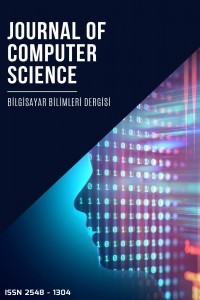Novel Machine Learning (ML) Algorithms to Classify IPv6 Network Traffic in Resource-Limited Systems
Embedded systems, machine learning, lightweight ML algorithms, IPv6 Network, cyber attack
Novel Machine Learning (ML) Algorithms to Classify IPv6 Network Traffic in Resource-Limited Systems
Embedded systems, machine learning, lightweight ML algorithms, IPv6 Network, cyber attack,
___
- Aamir, M., & Zaidi, S. M. A. (2021). Clustering-based semi-supervised machine learning for DDoS attack classification. Journal of King Saud University-Computer and Information Sciences, 33(4), 436-446.
- Alieksieiev, V., & Andrii, B. (2019, September). Information analysis and knowledge gain within graph data model. In 2019 IEEE 14th International Conference on Computer Sciences and Information Technologies (CSIT) (Vol. 3, pp. 268-271). IEEE.
- Beloglazov, A., Abawajy, J., & Buyya, R. (2012). Energy-aware resource allocation heuristics for efficient management of data centers for cloud computing. Future generation computer systems, 28(5), 755-768.
- Ferrag, M. A., Maglaras, L., Moschoyiannis, S., & Janicke, H. (2020). Deep learning for cyber security intrusion detection: Approaches, datasets, and comparative study. Journal of Information Security and Applications, 50, 102419.
- Ge, M., Fu, X., Syed, N., Baig, Z., Teo, G., & Robles-Kelly, A. (2019, December). Deep learning-based intrusion detection for IoT networks. In 2019 IEEE 24th pacific rim international symposium on dependable computing (PRDC) (pp. 256-25609). IEEE.
- Gupta, C., Suggala, A. S., Goyal, A., Simhadri, H. V., Paranjape, B., Kumar, A., ... & Jain, P. (2017, July). Protonn: Compressed and accurate knn for resource-scarce devices. In International conference on machine learning (pp. 1331-1340). PMLR.
- Khandagale, S., Xiao, H., & Babbar, R. (2020). Bonsai: diverse and shallow trees for extreme multi-label classification. Machine Learning, 109(11), 2099-2119.
- Khraisat, A., Gondal, I., Vamplew, P., Kamruzzaman, J., & Alazab, A. (2019). A novel ensemble of hybrid intrusion detection system for detecting internet of things attacks. Electronics, 8(11), 1210.
- Lai, L., Suda, N., & Chandra, V. (2018). Cmsis-nn: Efficient neural network kernels for arm cortex-m cpus. arXiv preprint arXiv:1801.06601.
- Lamping, U., & Warnicke, E. (2004). Wireshark user's guide. Interface, 4(6), 1.
- Lonea, A. M., Popescu, D. E., & Tianfield, H. (2012). Detecting DDoS attacks in cloud computing environment. International Journal of Computers Communications & Control, 8(1), 70-78.
- SaiSindhuTheja, R., & Shyam, G. K. (2021). An efficient metaheuristic algorithm-based feature selection and recurrent neural network for DoS attack detection in cloud computing environment. Applied Soft Computing, 100, 106997.
- Sakr, F., Bellotti, F., Berta, R., De Gloria, A., & Doyle, J. (2021). Memory-Efficient CMSIS-NN with Replacement Strategy. In 2021 8th International Conference on Future Internet of Things and Cloud (FiCloud) (pp. 299-303). IEEE.
- Tekerek, A. (2021). A novel architecture for web-based attack detection using convolutional neural network. Computers & Security, 100, 102096.
- Tertytchny, G., Nicolaou, N., & Michael, M. K. (2020). Classifying network abnormalities into faults and attacks in IoT-based cyber physical systems using machine learning. Microprocessors and Microsystems, 77, 103121.
- Tuor, T., Wang, S., Salonidis, T., Ko, B. J., & Leung, K. K. (2018, April). Demo abstract: Distributed machine learning at resource-limited edge nodes. In IEEE INFOCOM 2018-IEEE Conference on Computer Communications Workshops (INFOCOM WKSHPS) (pp. 1-2). IEEE.
- Volkov, S. S., & Kurochkin, I. I. (2020). Network attacks classification using Long Short-term memory based neural networks in Software-Defined Networks. Procedia Computer Science, 178, 394-403.
- Yang, T. J., Chen, Y. H., Emer, J., & Sze, V. (2017, October). A method to estimate the energy consumption of deep neural networks. In 2017 51st asilomar conference on signals, systems, and computers (pp. 1916-1920). IEEE.
- ISSN: 2548-1304
- Yayın Aralığı: Yılda 2 Sayı
- Başlangıç: 2016
- Yayıncı: Ali KARCI
Evrişimsel Sinir Ağları ile Konuşmadan Duygu Tanıma Sistemi
Metehan AYDİN, Bülent TUĞRUL, Yilmaz AR
Akademik Yazılarda Resim İntihal Kontrolü Sistemi
Transfer Learning-Based Classification Comparison of Stroke
Rusul Ali Jabbar ALHATEMİ, Serkan SAVAŞ
EMG Sinyallerinin HFD Analizi ve Hareket Sınıflandırılması
Gazi AKGÜN, Uğur DEMİR, Alper YILDIRIM
Denim Kumaşından Otomatik Yüksek Çözünürlüklü Bıyık Desen Sentezi
Emrullah ŞAHİN, Muhammed Fatih TALU
Derin Öğrenme Tabanlı Görüntü İşleme İle Acil Durum Tespiti
Mustafa GÖKSU, Şafak GÖKSU, Ahmet ALKAN
IoT Botnet Verisetlerinin Karşılaştırmalı Analizi
5G Sistemleri için DL Tabanlı Kanal Tahmini
Beyin Tümörü Bölütleme ve Algılamada Yeni Çekişmeli Üretken Ağ Kullanılması
